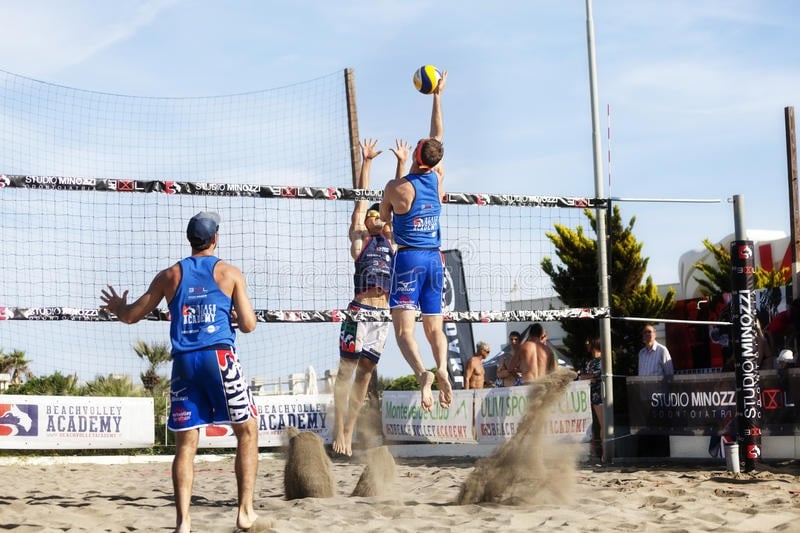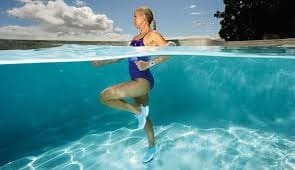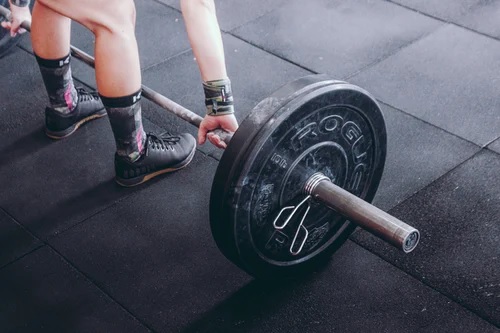
In volleyball, the running, standing, squatting and countermovement jumps are executed almost in equal measure. When determining How To Jump Higher For Volleyball all of those facets must be considered.
The one common denominator - or overarching theme - with all of those movements is that the functionality of the lower body is always paramount.
Plyometrics In Your Volleyball Jump Training
Plyometrics exercises significantly increase muscle strength, the stability in your joints and the coordination of your body when jumping. This is achieved by Targeting Essential Muscles that are used during the jump motion.
By performing Plyometrics you are building the Explosive Power, which you need to Jump Higher. In a sport like volleyball, where there is so much jumping from a standing position, Building Your Lower Body is essential.
This time, we are going to opt for a slight paradigm shift, for those who have never heard of aquatic plyometrics training.
1-) Aquatic Plyometrics workout

1-
Drill Name: Egg-Beater
Drill Purpose: To make your legs stronger
Drill Direction:
- At its heart, the egg-beater is a drill that involves the kicking of the legs below the water, while keeping your head above the water. Here, you are treading water but in a very specific way.
- You perform this drill by rotating both of your legs, in opposite directions. One of your legs will rotate inwards, while your other leg will rotate outwards. Beyond the strength demands, which will become apparent pretty soon in this drill, there are also demands on your level of coordination. Coordination, as we all know, is a major component of jumping in volleyball.
- This can be a daunting exercise at first, especially if you are not a strong swimmer but there are ways to help you get through it, while making sure that you are doing the leg rotations properly. Everybody is scared of drowning, even the professional divers.
- On that score, buoyancy belts, flutter boards and pool noodles are not illegal. In fact we encourage the use of them, if that means you will be better placed to perform the drill properly.
Suggested Workout: Propel your body into the air for 30 seconds at a time.
Suggested Sets: Two Sets Per Session
2-
Drill Name: Treading Water
Drill Purpose: To make your legs stronger and increase power output
Drill Direction:
Suggested Workout: Repeat 30-Second Spells
Suggested Sets: Three Sets Per Session
3-
Drill Name: Pool Crunches
Drill Purpose: To strengthen your abdominal coreDrill Direction:
Suggested Workout: 20 Crunches Per Set
Suggested Sets: Three Sets Per Workout
4-
Drill Name: Core Toners
Drill Purpose: To strengthen the abdominal core and tone the legs
Drill Direction:
Find the edge of the swimming pool and lift yourself up with your arms.
When your arms are fully stretched, lift your legs up until they are fully extended in front of you.
Make sure you do not lose your form for the duration of this drill.
When you are ready, start splitting your legs apart and then close them again, against the aquatic forces of course.
Suggested Workout: 20 Splits
Suggested Sets: Three Sets
Why Should You Add Aquatic Plyometrics Exercises To Your Volleyball Training?
We recommend these exercises, not because the results will be overwhelmingly different to those recorded with the more traditional plyometrics methods but rather because there is compelling evidence to suggest that aquatic plyometrics can make a meaningful contribution to your longevity on a volleyball court.
- You are likely to jump at your peak for more sustained periods if you take to aquatic plyometrics training
- Your vertical jump improves more and faster when training in the water
- Training in water increases the power output in your lower limbs
- You can continue with your conditioning and rehabilitation work, without risking further injury. That is something also worth storing at the back of the memory compartment when training to To Increase Your Vertical Jump For Volleyball.
2-) Weightlifting Exercises

1-
Drill Name: Dumbbell Squats
Drill Purpose: To strengthen all of the muscle groups in the lower body
Drill Direction:
Reps: 15 Reps
Sets: 3 Sets
2-
Drill Name: Hip Bridges
Drill Purpose: Increase strength in your glutes, hamstrings and abdominal region
Drill Direction:
Reps: 12 Reps
Sets: 4 Sets
3-
Drill Name: Preacher Curls
Drill Purpose: This Volleyball Jump Training drill is all about the biceps. Be careful not to overdo these though. You don’t really want to look like Arnold Schwarzenegger. However, you do want to be ripped enough to help propel your body into the air and actually function well as a volleyball player who does a lot of serving, blocking and spiking.Drill Direction:
Find a preacher bench in a gym, which is the only place you are likely to pull this workout off.
Put a suitably weighted barbell on that bench. You should know how much you can and cannot handle.
Lift and lower the barbell for the recommended amount of time.
Reps: 12 Reps
Sets: 4 Sets
4-
Drill Name: Hamstring Curls
Drill Purpose: Increase the strength of the hamstrings and glutes
Drill Direction:
Find a leg curl machine in the gym, which is also probably the only place you are doing to be able to perform this Volleyball Jump Training drill
Lie down on that bench, tummy facing own or back facing up
Then flex your legs upwards, towards the buttocks and lower them again, for the recommended number of times
Reps: 12 Reps
Sets: 2 Sets
Why Should You Add Weightlifting In Your Volleyball Jump Training?
The best - although not the only - way to help prevent a series of injuries is to dedicate a considerable amount of your volleyball training to strength workouts.
In Addition, jumping higher requires increased power and increased power is the by-product of strength training, especially when it comes to the upper body.
Exploiting opportunities to produce more power from the abdominal core and the upper limbs matters most in volleyball jump training.
How To Improve Jump Technique
Make more room for better footwork.
Use your arms to guide you when jumping on the volleyball court
Work particularly hard on building up your endurance, not just coordination and movement.
Volleyball Jump Training Tips
Try and adopt volleyball jump training regimens that will be intellectually and physically stimulating.
Have people around you while training, to keep you stimulated, to motivate you and to help you during your training.
If you are not comfortable with an exercise, for whatever reason, you can and should always try and look for alternatives.
Fast, upbeat music can help you get through a training session better
Conclusion
Jumping higher in volleyball is a more cerebral enterprise that it would ordinarily be in any other jumping activity. That means the kind of training you perform, with the view to jumping higher in volleyball, needs to also be slightly out of the box.
Aquatics plyometrics has featured heavily in this blog. While we will not call it groundbreaking stuff, it is certainly taken for granted. We think it would behove you to pursue this line of training more aggressively, when pursuing your volleyball ambitions.
Do that without compromising on the other, more traditional training methods though. We certainly don’t think you would be compromising on outcomes at all (you will probably improve most jumping outcomes) and we believe you will be giving your body a few more months and perhaps even years on the volleyball court.
Hey, I’m Aleksandar and I am a Basketball freak! That is why I decided to create this blog. Teaching people How to dunk a basketball and How to Jump Higher in this sport or other related sports that require vertical jumping, is my specialty. If that’s your aim, then you have come to the right place.
